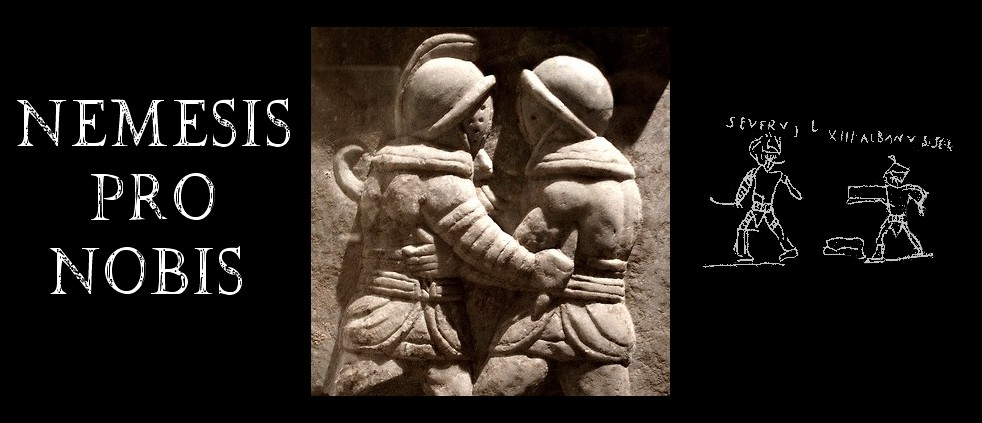Texte en anglais, je traduis plus tard quand j'aurais plus de temps


This brooch may validate my theory that some Roman gladiator colleges
had a belief in resurrection, at the very least it shows that some fans
(most likely female) believed that; at least one Murmillo (fish man)
gladiator had been resurrected, or that the Murmillo gladiator was
connected to the concept of resurrection, or all gladiators were
connected to such a concept (or any combination of those, or all of
those). Inside the Murmillo helmet near the top there appears to be a
large mustached figure (possibly with one eye), this may be a Gallic or
Germanic sea god, the Murmillo was also known as the "Gaul", the reason
for this is unexplained. The triangular sword has inscriptions on it,
the larger Roman letters appear to spell "SIAR" or SIARS, it may be the
Gallo / Celtic word "Siar" that means "West", this may be a reference to
a western Gallic tribe, or? If the sword is viewed from the side with
the tip downward, it will appear as a triangular face with a pilum
(imperial Roman military javelin) head for an ear, he is wearing a
turban (from the hand guard padding of the gladiator, the turban being a
reference to Middle Eastern Christians?)), the central part of the face
appears as a chalice. The top of the turban (the pommel) also appears
as a hawk or an eagle head. While in this position, to the lower left
(on the shield) there is a stout bearded figure with a large nose
wearing a hood. The shield has a large line design that is the shape of a
stylized eagle or hawk head. The diagonal line of this is also a type
of long thin herm (it has a head on top), to the top front of this line
there is a black woman (in niello) with an oval piece of copper. The
horizontal bottom line has an eagle's head (in the other position this
is the bearded hooded figure) that appears as if biting a tail. This is a
type of "eagle or hawk headed ouroboros" (a Greek word meaning tail
swallower that is usually a serpent or a snake), it is a very ancient
universal symbol of resurrection, if the bird is a hawk then this
suggests Horus, the Egyptian god of resurrection . Under this line to
the right as an idol type large breasted woman (viewed from the left she
appears as if veiled). If the brooch is put on it's other side the head
of the eagle (that is also the bearded hooded figure) will turn into a
short man (with a ball on his head) holding a chalice, next to him is a
taller figure that appears to be a woman, in front of this taller figure
is the letter M on top of a V. There are depictions of various figures
on the legs and on the back of the brooch. . The black woman (in niello)
on the shield is reminiscent of the Greek black figure pottery (popular
C. 700 to 530 BC), she should be the goddess Aphrodite, but as her
Roman equivalent Venus, the copper and the dolphin suggests that she is
specifically of the Isle of Cyprus, the dolphin may in fact be a
stylized outline of that island (from a northern perspective). The woman
on the bottom appears as an ancient matronly priestess or goddess (a
priestess of the goddess Juno?), she appears as if commanding the
diagonal herm. On both sides in back there are copper inserts in bronze
pin swivel bar holders. The copper insert on the right (in back of the
gladiator's left foot) appears to be connected to the figures on the
right side of the shield. This shows two long women as if kissing that
are near and on a bowl (one figure is on the bowl), the bowl is actually
the pin's swivel bar. In front of this scene is a large triangle with
the point down, this has a face of a man in profile (as if viewing the
scene on the bowl. The lines on top and below this the copper insert
show what appear to be crosses on top and figures on the bottom. Behind
this (on silvered bronze) is another triangle but with the point up.
From a slightly side angle the scene on the pin's swivel bar shows a
dark haired woman (with a large earring?) as if kissing a small girl
with hood or a hair net, the lines on top and below this on the copper
insert are now somewhat more defined, they show what appears to be a
ritual (or a parade, or a battle?), on top there is a rectangle face
(but as or on a shield?), spears, oval shields, and crosses. This scene
may be of gladiator ritual, or a Gallo / Celtic or Germanic ritual,
although it is doubtful there is a connection, the cross would later
become a Christian symbol. The engraving on the pin swivel bar on the
other side shows a helmeted or crowned figure holding either a palm, a
sword. or a staff, this may be a victorious gladiator. The depictions
seen on this brooch appears to be of various cultures of the provinces
of the Roman Empire, it also appears that these were cultures that
believed in the concept of resurrection of the dead.
Source : http://romanofficer.com/PermcolC.html